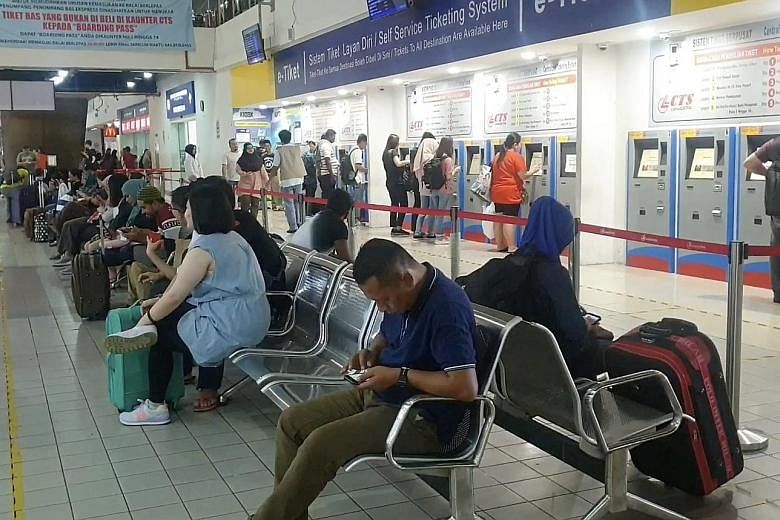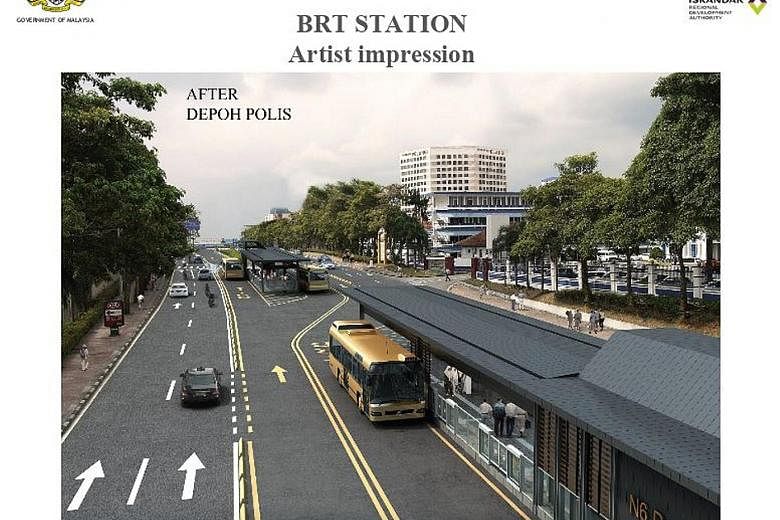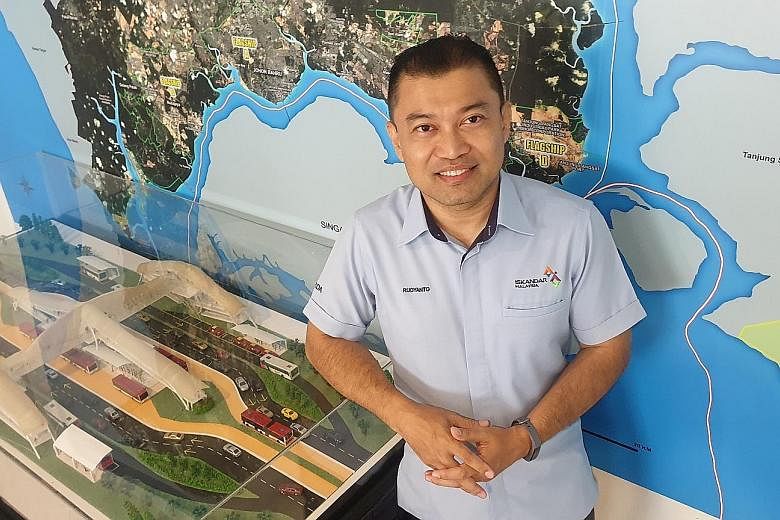At a busy intersection outside Johor's largest bus terminal at Larkin, buses, cars and trucks were bumper to bumper. Pedestrians and touts were milling about amid the honking by impatient drivers whose ire was aimed at illegally parked vehicles along the pavement.
Come 2022, such chaotic scenes in Malaysia's southern economic development region might be a thing of the past, as the Iskandar Regional Development Authority (Irda) prepares to roll out a comprehensive plan called the Bus Rapid Transit, or BRT, to beat congestion and pollution and encourage more people to use public transport.
As its name suggests, the BRT combines the speed and reliability of the light rail transit (LRT) with the affordability of a conventional bus system, Mr Rudyanto Azhar, Irda's director of Iskandar Malaysia Bus Rapid Transit told The Sunday Times as he unveiled the latest plans on May 10.
First conceptualised in the Transportation Blueprint for Iskandar Malaysia in 2009, the authorities are currently selecting consultants who will firm up the finer details of the design, among other things. Construction is poised to start in the first quarter of next year, with the BRT service targeted to commence in the first quarter of 2022, he said.
The project, which will cost RM2.56 billion (S$846 million) and be financed by the government and private sector, is "a fraction of the cost" of building an LRT, said Mr Rudyanto. He disclosed that RM 1 billion will come from the federal government.
"It's been a long battle... Throughout our studies, we have looked at various alternative systems, and Bus Rapid Transit is the system of choice for the moment," he said.
BRT IN 170 CITIES
When the BRT is ready, high-capacity buses will ply dedicated bus lanes on three main routes connecting downtown Johor Baru to industries and residential areas in Tebrau in the east, universities and small and medium-sized enterprises in Skudai in the north, and new growth areas in Nusajaya in the west.
There will be 39 stations along the 51km-long trunk lines, including stops at Larkin, Bukit Chagar near the Causeway, and Medini near the Tuas Second Link.
As an integrated public transport service, the BRT will also be supported by 42 suburban feeder services plying existing roads and 26 direct services to populated areas such as malls, hospitals and tourist spots like Legoland and Pasar Borong Pandan City.
These air-conditioned buses with Wi-Fi on board will run on clean energy at regular intervals, slashing waiting and travelling times for commuters while reducing pollution and traffic jams.
The BRT may be new in Malaysia, but not in the world. As of January this year, 170 cities have implemented BRT systems, serving more than 33 million people a day, according to Global BRT Data, an online database created and maintained by the World Resources Institute.
In South-east Asia, the TransJakarta in the overcrowded Indonesian capital has been running since 2004, and the Bangkok BRT in Thailand's capital has been in service since 2010. In Vietnam, the first BRT was launched in Hanoi on the last day of 2016, but a plan to build a second route in Ho Chi Minh City has been scrapped due to high cost and low ridership estimates.
Irda says Johor's BRT will be modelled after existing systems around the world, including Bogota in Colombia and various cities in China such as Guangzhou.
The revamped bus network will cover 90 per cent of the sprawling Iskandar Malaysia, up from the current 39 per cent, Mr Rudyanto said.
With better connectivity and accessibility, he hopes more people will use public transport. Less than 10 per cent of the region's two million population currently do so.
He said: "This will give people the impetus to leave their cars and motorbikes at home."
Johor residents welcomed the BRT initiative although some insisted they would stick to the convenience of driving to get around.
Sales assistant Imran Abdul Halim, 26, said: "I have been yearning for a sophisticated bus system that is orderly and goes directly to various locations."
He added: "The current bus network in Johor is messy.
"The buses can be as late as by an hour, two hours, or don't come at all. It's so difficult."
REDUCING CAUSEWAY JAMS
The upcoming BRT is also aimed at easing massive traffic jams at the Causeway and accommodating the potential surge in commuter numbers from the future rail links connecting Malaysia to Singapore.
Ms Kamisah Mohd Ghazali, Irda's senior vice-president of planning and compliance, told The Sunday Times there will be direct bus services from the BRT to the now-postponed rail projects, namely, the Kuala Lumpur-Singapore High-Speed Rail (HSR) railway and the Johor Baru-Singapore Rapid Transit System (RTS) Link.
"If we have RTS without BRT, then how do we disperse commuters. We need to get BRT on the ground, we must have it so that you have a system that caters for intra-Iskandar Malaysia that is reachable by 90 per cent of the populated areas," she said.
The RTS project has been suspended for six months from April 1 this year and the HSR project, up till May 31 next year. But Irda officials were hopeful the RTS project will go ahead as an enduring solution to the perennial traffic jam at the border.
"The congestion on the Causeway has been like this for years. There must be a solution. After 30 years, we can't be living in the same conditions considering Iskandar Malaysia is moving towards becoming a strong and sustainable international metropolis," said Ms Kamisah.
Mr Rudyanto said the BRT will benefit Johoreans who shuttle every day to Singapore to work.
"They can have better quality of living instead of having to wake up at 4 in the morning," he said.
Singaporeans too would not need to drive or ride into Johor to shop, eat and relax. Those with businesses in Johor, or who wish to shift their operations there, could also travel more conveniently and cheaply.
"With RTS coming in and with the accessibility within Iskandar Malaysia, there will be better viability for them to establish their joints here," Mr Rudyanto added.




